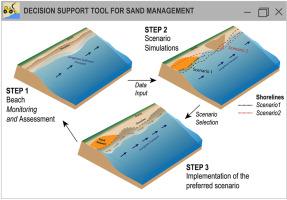Ocean & Coastal Management ( IF 4.8 ) Pub Date : 2021-09-09 , DOI: 10.1016/j.ocecoaman.2021.105887 Guilherme Vieira da Silva 1 , Darrell Strauss 1 , Thomas Murray 1 , Rodger Tomlinson 1 , Joshua Taylor 2 , Paul Prenzler 2

|
Implementing coastal protection strategies presents challenges for coastal managers, particularly in the absence of data driven historical learnings. These challenges are expected to increase with the growing pressures of urbanisation on the coastline and potential impacts of climate change. In an operational setting, where decision making needs to be undertaken in a timely and costly manner, while achieving the best possible outcomes, decision support tools serve an important role. This paper presents a framework for developing a decision support tool to support coastal protection, in particular sand resource management. The framework was developed in a partnership between a local government authority and academia and will be implemented to manage beach nourishments via a sand-backpassing decision support tool. To apply the framework and develop the tool, a calibrated numerical model was used to simulate a series of potential scenarios of dispersion of sand placement that include different wave conditions, initial beach profile condition (e.g. eroded, accreted, average) and volume of sand to be placed at three separate beach locations. The user can weight the relative importance of each location as well as the dispersion rates and beach state to rank the preferred location to place the sand for the best outcome. Here, we demonstrate the importance of the feedback process between beach morphology evolution, incoming waves and the volume of the nourishment on the evolution and dispersion of the sand placement. Moreover, by using the tool the user can identify the best locations to place the sand supporting operational sand management decision making by the local government authority. The framework presented here is flexible and can be used and adapted for other locations and applications where the morphodynamic feedback is important in predicting the lifetime of a sand management strategy. Finally, the importance of the engagement between academia and government for the development of effective coastal protection strategies is demonstrated and highly encouraged.
中文翻译:

通过沙子回传建立沿海弹性 - 开发沙子管理决策支持工具的框架
实施海岸保护战略给海岸管理者带来了挑战,特别是在缺乏数据驱动的历史学习的情况下。随着海岸线城市化压力的增加和气候变化的潜在影响,这些挑战预计会增加。在运营环境中,需要及时且成本高昂地做出决策,同时实现可能的最佳结果,决策支持工具发挥着重要作用。本文提出了开发决策支持工具以支持海岸保护,特别是沙子资源管理的框架。该框架是由当地政府当局和学术界合作开发的,将通过沙子回传决策支持工具实施以管理海滩营养。为了应用该框架并开发该工具,使用校准的数值模型来模拟沙子分布的一系列潜在场景,包括不同的波浪条件、初始海滩剖面条件(例如侵蚀、堆积、平均)和沙子体积被放置在三个不同的海滩位置。用户可以对每个位置的相对重要性以及分散率和海滩状态进行加权,以对放置沙子的首选位置进行排序以获得最佳结果。在这里,我们展示了海滩形态演变、传入波浪和营养量对沙子放置的演变和分散之间的反馈过程的重要性。而且,通过使用该工具,用户可以确定放置沙子的最佳位置,支持当地政府当局制定操作性沙子管理决策。这里介绍的框架是灵活的,可以用于和适应其他位置和应用程序,在这些位置和应用程序中,形态动力学反馈对于预测沙子管理策略的寿命很重要。最后,学术界和政府之间的合作对于制定有效的海岸保护战略的重要性得到了证明和高度鼓励。











































 京公网安备 11010802027423号
京公网安备 11010802027423号